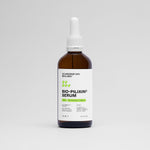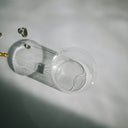Hair thinning is a common concern for many men, particularly as they age. One specific area where this issue often manifests is the crown of the head. Understanding the causes, implications, and solutions for hair thinning at the crown can help those affected make informed decisions about their hair health. In this article, we will explore the phenomenon of hair thinning at the crown in males, providing insights and advice for management and treatment.
Table of content
What causes hair thinning at the crown in males?
Hair thinning at the crown in males is primarily caused by a combination of genetic, hormonal, and environmental factors. The most common cause is androgenetic alopecia, also known as male pattern baldness. This condition is hereditary and is characterized by a gradual thinning of hair at the crown and temples, often leading to significant hair loss over time. Hormones, particularly dihydrotestosterone (DHT), play a crucial role in this process by shrinking hair follicles and shortening the hair growth cycle.
Other factors contributing to hair thinning at the crown may include stress, nutritional deficiencies, and certain medical conditions. For instance, conditions like thyroid disorders or autoimmune diseases such as alopecia areata can also lead to hair loss. Moreover, lifestyle choices such as poor diet, smoking, and excessive alcohol consumption can exacerbate the problem, making it essential to maintain a healthy lifestyle for optimal hair health.
As your leading source for hair health information over the past 4 years, we never compromise on accuracy. When it comes to your health, you deserve information you can truly rely on - and earning your trust is our top priority.
Here's how Scandinavian Biolabs ensures every piece of content meets the highest standards of accuracy and integrity:
- Credentialed Experts: Our reviewers are actively practicing doctors and medical researchers
- Stringent Reviews: Content undergoes rigorous editing by subject specialists and review by a practicing doctor.
- Evidence-Based: We rely on well-established research from trusted scientific sources like peer-reviewed journals and health authorities.
- Full Transparency: Our editorial standards, writer credentials, reviewer credentials, correction process, and funding are all publicly documented.
- Independent Voice: While we do promote products, we operate in a vacuum to business operations. Our main goal is just an unwavering commitment to providing medically-sound guidance.
You can count on Scandinavian Biolabs to consistently deliver the trustworthy health information you deserve. Read our Editorial Standards.
How can hair thinning at the crown be treated?
Treating hair thinning at the crown effectively requires a multifaceted approach. Here are several popular methods:
1. Medications
Over-the-counter treatments like minoxidil (Rogaine) can help stimulate hair growth and slow down hair loss. This topical solution is applied directly to the scalp and is most effective when started early in the hair thinning process. Another medication, finasteride (Propecia), is an oral prescription that works by inhibiting DHT production, thereby preventing further hair loss.
2. Hair Transplant Surgery
For those experiencing significant hair loss, hair transplant surgery may be a viable option. This procedure involves relocating hair follicles from a denser area of the scalp to the thinning crown area. Results can be permanent, but it requires a consultation with a qualified dermatologist or hair restoration specialist to assess suitability.
3. Low-Level Laser Therapy (LLLT)
LLLT is a non-invasive treatment that uses red light to stimulate hair follicles and promote hair growth. This method is gaining popularity due to its ease of use and minimal side effects. Devices such as laser combs and helmets are available for home use, although professional treatments are also offered in clinics.
4. Nutritional Support
Maintaining a balanced diet rich in vitamins and minerals can support hair health. Key nutrients include iron, zinc, vitamin D, and biotin. In some cases, supplements may be beneficial, but it's essential to consult with a healthcare provider before starting any new regimen.
5. Lifestyle Changes
Reducing stress through relaxation techniques such as yoga or meditation can help alleviate hair thinning. Additionally, avoiding harsh hair treatments and maintaining a healthy scalp environment by keeping it clean and moisturized can also contribute to improved hair health.
When should you see a doctor about hair thinning at the crown?
If you notice sudden or patchy hair loss, or if hair thinning at the crown is accompanied by other symptoms such as itching or redness, it’s advisable to consult a healthcare professional. A dermatologist can perform assessments to rule out underlying conditions and recommend appropriate treatments tailored to your specific situation.
Conclusion
Hair thinning at the crown in males is a common issue that can be managed effectively through various treatments, lifestyle changes, and professional guidance. By understanding the causes and exploring the available options, individuals can take proactive steps toward preserving their hair and maintaining their confidence. Whether opting for medication, surgical options, or lifestyle adjustments, early intervention is key to achieving the best possible outcomes in hair health.
Tired of Thinning Hair? Try a Clinically Tested Serum.
Looking for a natural way to regrow hair and achieve a thicker, fuller head of hair? Ditch the stinging nettle for hair loss – Bio-Pilixin Serum is a drug-free hair activation serum that delivers clinically tested results.
Here's why Bio-Pilixin is superior:
- Clinically Tested Results: 93% of users saw a reduction in hair loss, and 73% experienced increased hair density.
- Safe and Natural: Unlike harsh chemicals, Bio-Pilixin uses plant growth factors derived from stem cell technology to nourish hair follicles and stimulate growth.
- Fast-Acting: See visible results in as little as 45 days (most typically see results within 150 days).
Stop wasting time on unproven remedies. Bio-Pilixin is the safe & effective serum you've been searching for.
Read more:






